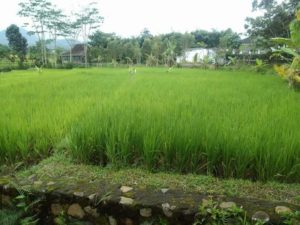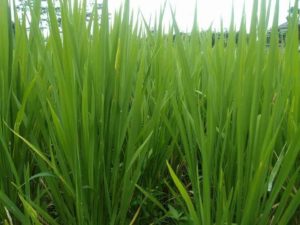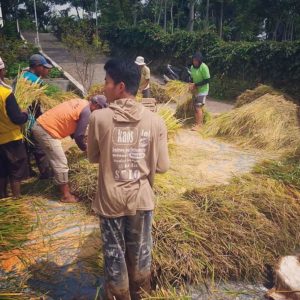TRIPLE-PRONGED INTEGRATED EMISSION REDUCTION STRATEGY
My name is Brett Pritchard and I am a 57 years old Australian. I gained my Diploma of Permaculture Design in 1992 and graduated with a Bachelor of Natural Environments and Wilderness Studies in 2007. As part of my degree I studied Climate Change Science and Policy at the Australian National University and Tropical Soils at James Cook University. I have spent much of the past five years trialling an urban food growing system for the dry tropics. There is some more info about me and my skills, education and experience on my LinkedIn profile here.
This food growing system is based on soil-filled containers inoculated with a probiotic mix that contains purple non sulphuric photosynthetic bacteria. The ‘BioWicked Inoculate’ replaces the methanogenensis microbiome with beneficial bacteria that pulls atmospheric nitrogen into wet anaerobic soil and carbon dioxide into drier aerobic soil. This provides free nitrogen and boosts soil carbon, improving soil structure and water and nutrient holding capacity. I call them BioWicked beds as nutrients and bacteria wick up with the irrigation water. I’m currently working on a web site at biowicked.com that will explain this carbon-negative method of urban food growing I’ve developed. This isn’t however what my proposal is about (please keep reading).
I also do self-funded overseas aid work and recently assisted running permaculture aid courses in the Philippines (October 2014, September 2015). My first overseas aid experience was in 1991-93 when I lived in a Penan village in the Borneo rainforest in Sarawak (Malaysia) for two years. The villagers had been nomadic hunter gatherers and had only settled around 1970 and so had no tradition of agriculture. I gained support for the two year project from the Sarawak government who supplied materials and chickens. One tree species I introduced to the village was Inga edulis, commonly known as ice cream bean due to the white fluffy ‘fruit’ around the seeds in its long pods tasting like vanilla ice cream. This is now a popular village tree throughout Sarawak. We also planted 10,000 native fruit trees and 10,000 sago palms in the secondary rainforest around the village.
I returned in 2009 to try to establish a REDD carbon offset project. A palm oil company was moving closer to the two villages I had worked with in the 1990s, Long Bangan and Long Win, and I hoped to initiate a REDD carbon offset project as a way of both saving the villagers intact rainforest and getting them funds for sustainable development. Many still only have old 44 gallon drums for water and cook over smoky indoor fires. Between 2009 and 2012 I self-funded seven trips from Australia to Borneo, often staying for months at a time, and slowly managed to get the Sarawak State Government and the oil palm company with the concession over the village traditional land to agree. From the proceeds of the carbon offsets a local company set up to finance the costs of initiating and managing the project was to receive 30%, the palm oil company 30%, the village 35%, and I was to get 5% to enable me to return annually for about 10 years and assist in their sustainable village development. Unfortunately just prior to signing an Australian conman Brett Goldsworthy announced through Reuter that he had just signed up 12 headman and 100,000 hectares on Sarawak forest as carbon offset. The government advised the company to pull out as they were concerned I was involved. The bottom then dropped out of the carbon offset market so I didn’t revisit it, though a Penan friend Paulus told me recently that there are quite a number of Penan villages who heard of it who are interested in carbon offset as a way of having both their forest/traditional culture and money for development. This still isn’t the proposal either, so please bear with me.
When I first worked in Paulus’s village of Long Bangan in 1991 there were around 300 people but the population has now risen to about 500. When the village settled they copied the other Dayak tribal groups and began using growing slash and burn / swidden agriculture to grow rice. They clear an area then once the brush is dry the burn, then dibble seeds into the ash bed. An area is fertile for one or two growing seasons then needs to be left fallow for six or seven years to recover. This means every family needs numerous fields. All of the flat land near the village is already claimed or has oil palm now growing on it, leading to people moving into the hillier rainforest reserve area the village uses for hunting and gathering. This is tragic and causing conflict in the village.
Last year I took Paulus to a 2 week Permaculture course in the Philippines and also introduced him to the theory of alley cropping. I have been in contact with Mike Hands of the Inga Foundation and will be going back in to Long Bangan in October 2016 to start a small Inga edulis alley crop trial. Mike Hands discovered that by using Inga edulis alley cropping in tropical soils in South America he could keep the field fertile as the Inga leaves in association with mycorrhiza recycle the phosphate, which is the limiting factor in tropical soils. If the trials are successful and adopted by Long Bangan the villagers will only need about a sixth of the current amount of land for agriculture, as they will be able to keep using the same plot every year.
SARAWAK PROPOSAL
This finally brings me to my Model Triple Pronged Greenhouse Gas Reduction Plan for Sarawak, to be rolled out throughout Asia if successful.
1. Currently the bulk of organic produce consumed in Sarawak is imported. There is a desire to expand organic food production, not just for domestic consumption but also for the rapidly expanding Chinese market for organic food. One problem is a lack of organic fertiliser. Bat guano is mined from some caves but there is little else available for farmers wanting to convert to organic farming. This could be solved if the Bio-Regen unit is rolled out in Sarawak. The Bio-Regen unit uses a similar microbial mix as the BioWicked Inoculate, and is a double food grinder unit for converting food waste to biofertiliser. Schools and markets are good locations, and food halls in shopping centres. The fermentation process kills e-coli, salmonella and other pathogens and organic waste such as fish waste and meat can be added. This process converts what is a huge contributor of methane into a high nutrient probiotic organic liquid fertiliser in just 28 days. However without a market for the fertiliser being established at the same time you can end up with thousands of litres of unwanted smelly liquid.
An cheaper alternative is for farmers to brew up the BioWicked Inoculate from a mother culture sent from Australia and produce biofertiliser by fermenting manures and plant matter. As the inoculate is very stable it is possible to cheaply brew up thousands of litres from one litre of mother culture, making it cheaper for poor farmers than chemical fertilisers.
2. The second prong is to start a large Inga edulis alley crop trial near Miri. The organic biofertiliser either produced by the Bio-Regen or brewed by farmers from the BioWicked Inoculate can be used for nutrients and to help stimulate mycorrhiza growth. I believe that by using this probiotic fertiliser the results could be better than the South American trials. The alley cropping technique could be used by both commercial agriculturalist and market gardeners and it could even be trialled as a way of growing organic palm oil. Where it will reduce the most emissions though is where it can be introduced to those Dayaks still practicing slash and burn agriculture in rainforest areas as the amount of land required for alley cropping agriculture is about a sixth required for slash and burn. It will be readily adopted once a few pilot projects go in as it entails less work for a higher yield and the villagers have less distance to go as they can keep using their field which is closest to their village every year.
3. The third prong is to do trials on wet paddy fields to see if the BioWicked Inoculate will stop the methane emissions. When I was in the Philippines I was amazed at the methane bubbling in the fields, considering the majority of it travels through the plant and is expelled invisibly. As I mentioned earlier on in this long email I use the inoculate to stop the wet soil in the base of my BioWicked wicking beds from emitting methane. Looking across the rice fields in the Philippines in late 2014 it just hit me that there is no reason it wouldn’t do the same in the paddy fields. When they are flooded and growing rice the inoculated fields would be taking in nitrogen from the air rather emitting methane, giving free fertiliser and avoiding ghg emissions all in one go. Then when the fields are drained the purple non-sulphuric photosynthetic bacteria begins to sequester carbon. The world’s rice fields could be converted from being the largest single ghg emitter of any crop into carbon sinks, using cheaply made fertiliser from food waste.
So in conclusion what I am proposing is a holistic plan with multiple opportunities for greenhouse gas reductions.
1. Methane from food waste is avoided. Currently waste food is dumped in Sarawak where it can cause disease and attract rats and insects. This system is also much better for the health of the people.
2. Carbon dioxide emissions from burning rainforest are avoided by replacing swidden with alley cropping, and carbon is locked up by allowing over 4/5 of the current swidden fields to revert back to forest.
3. Carbon dioxide emissions from commercial agriculture are avoided. Tilling and turning soil oxidises the carbon and converts it to carbon dioxide. Burning biomass is halted and the cut vegetation is used as mulch. With the Inga edulis alley crop system nitrogen, carbon and phosphate are sequestered and cycled through the system. The trees shade out weeds, then once a year are lopped and used to mulch between the rows. The crops are planted through the mulch. The Inga grow back and the cycle is repeated annually.
4. Nitrous oxide emissions from agriculture are avoided by replacing nitrogen fertiliser with nitrogen sequestering bacteria. Both chemical agriculture through the use of ammonia type fertilisers and organic farming through the overuse of animal manures produce nitrous oxide, a potent greenhouse gas almost 100 times the warming potential of carbon dioxide.
5. Methane emissions from rice paddy fields are avoided.
6. Carbon is sequestered in the fallow rice fields once they are drained.
I have spent over three years in total in Sarawak and know the country and people. A close friend who runs an adventure travel business there is also acquainted with the Minister for the Environment and the Minister for Rural Affairs. I am sure once I have a trial established I will be able to gain support for its expansion. While Mike Hands had €2 million for establishing his trials in South America I could do the above for much less. Is this the type of innovative project you are interested in funding or supporting? If so I can send further details and a breakdown and time line of the proposed project. I’m initially carrying out a small alley trial in an indigenous village as they are running out of land suitable for swidden agriculture. More information on this is available at here.
Sincerely yours,
Brett Pritchard
Townsville, Australia



